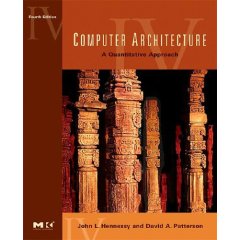Advanced Computer Architecture
Course
year: 2007-2008
| Code : |
5MD00 (3 ECTS) /
5Z033 (4 ECTS)
|
| Lecturers : |
Prof. dr. Henk Corporaal
Prof. dr. ir. R.H.J.M. Otten |
| Email : |
H.Corporaal at tue.nl |
| Phone : |
TU/e: +31-40-247 5195 or 3653
(secr. TU/e) / 5462 (office TU/e) |
| Assistance: |
Dr. ir. Sander Stuijk (miniMIPS
models + FPGA synthesis): s.stuijk at tue.nl
Ir. Akash Kumar (FPGA synthesis, LCC compiler): a.kumar at tue.nl
Dr. ir. Bart Theelen (miniNOC): B.D.Theelen at tue.nl
|
| Prerequisets: |
Course in computer architecture
and processor design; e.g. Processor Design 5Z032 or Computation 5JJ70;
Programming experience in C, C++, or equivalent language |
Information on the course:
Description and objectives
Studying the architecture, organization and use of the
newest (micro)processors currently on the market, and the latest
research developments in computer architecture. Architectures
exploiting instruction-level parallelism (ILP) and task-level
parallelism are treated. Starting from basic architecture concepts we
will end with
discussing the latest commercial processors (e.g., Pentium 4
multi-core, EPIC
processors like Itanium, and embedded processors such as the TriMedia),
and academic processors (like TRIPS).
This course also treats how processors can be combined in a
multiprocessing platform, e.g. by using a Network-on-Chip.
Interprocessor communication issues will be dealt with. Furthermore new
code generation techniques needed for exploiting ILP will be treated.
Special emphasis will be on quantifying design decisions in terms of
performance and cost.
The intention of the course is to give students the ability to
understand the design principles and operation of new (multi-)processor
architectures, and evaluate them both qualitatively and quantitatively.
Although we treat several examples, the emphasis will be on
architecture concepts. Furthermore, the aim is to design, implement and
test a Network-on-Chip, by one or more student teams.
Topics:
Basic principles (like instruction set design), pipelining and its
consequences; VLIW (very long instruction word) architectures,
Superpipelined, Superscalar, SIMD (single instruction, multiple data,
used in vector and sub-wordparallel processors) and MIMD (multiple
instruction, multiple data) architectures; Embedded architectures;
Out-of-order and speculative execution; Branch prediction; Data (value)
prediction; Design of advanced memory hierarchies; Memory coherency and
consistency; Multi-threading;
Exploiting task-level and instruction-level parallelism;
Inter-processor communication models; Input and
output; Network Communication Architecture; and Networks-on-Chip.
 |
Computer Architecture: A Quantitative Approach; 4th ed.
John L. Hennessy and David A. Patterson
Morgan Kaufmann Publishers
ISBN 1-55860-724-2 or 1-55860-596-7 |
Handouts (for slides see below):
Slides
** will be added and updated during the course period **
- Overview slides (including
preliminary schedule)
- Lecture 1: Computer Systems Overview
- Lecture 2 + 3: Crash course on MIPS
- Lecture 4:
Instruction-set design
- Lecture 5:
Instruction-Level Parallel (ILP) architectures
- Lecture 6: Exploiting ILP
with Software approaches
- Lecture 7: SMT: simultaneous
multi-threading
- Lecture 8: Multi-Processors and
Interconnection networks;
Including Synchronization, Coherence, and Consistency
- Lecture 9: Lab project
- Lecture 10: Caches and
Memory
Hierarchy;
Many techniques to speed up this memory hierarchy
Project
Part of the course will be project based. In this project the students
will program and modify an advanced processor network, using SystemC as
implementation language and, optional, FPGA as realization target
technology.
Students will work in a group of 2 people to perform this
project.
At the end
each group has to write an report about the lab.
assignments and
prepare a short (slide) presentation; clearly indicate the individual
contributions of both group members.
The results of the first two lab.
assignments have to be demonstrated per group (a date will be
determined for that).
The project contains three laboratory assignments.
Examination
The examination will likely be oral.
The grade is based on your project results (and being able to explain
and defend them) and the discussed theory (study all slides, book
chapters and handouts).
Related material and other links
- PreMaDoNA project website. Describes
our Network-on-Chip activities.
- Slides about IA64 and Itanium:
- IA-64 Architecture Innovations by John Crawford and Jerry
Huck (ppt)
(IA-64 at the Intel Developers' Forum February '99)
- IA-64 Overview by David Fotland
(ppt)
(IA-64 at the IEEE Vail Computer Elements Workshop in June '99)
- IA-64 Register Model: Stack and Rotation by Dale Morris (ppt)
(IA-64 at the IEEE Vail Computer Elements Workshop in June '99)
- Compiling for IA-64 by Carol Thompson (ppt)
(IA-64 at the IEEE Vail Computer Elements Workshop in June '99)
- Understanding the detailed Architecture of
AMD's 64 bit Core by Hans de Vries
Back to homepage of Henk Corporaal

